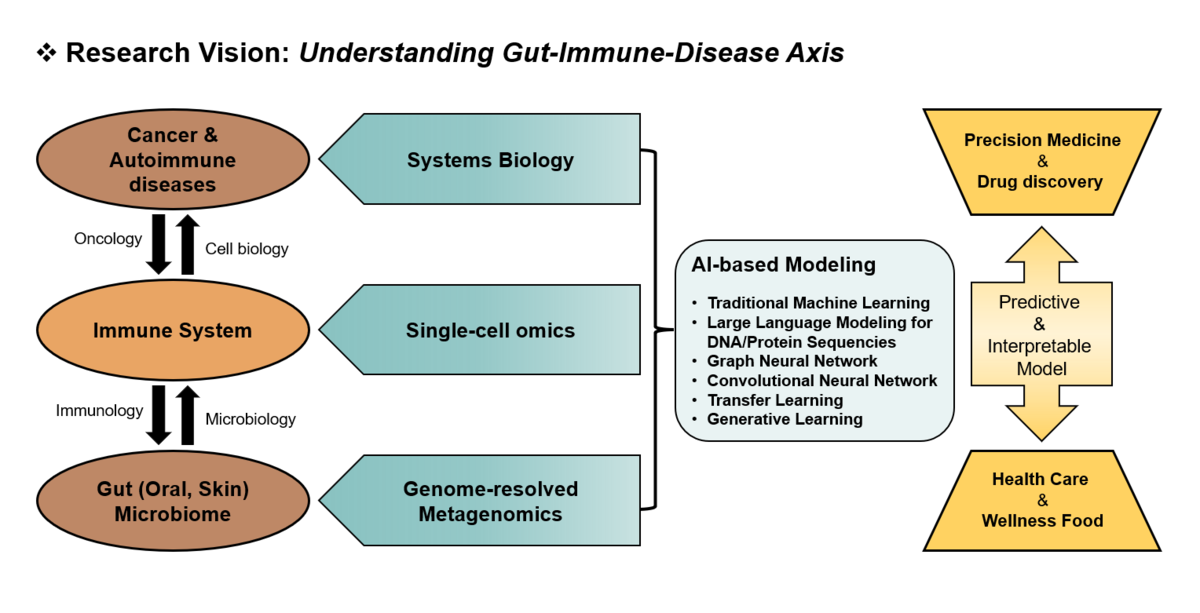|
|
| (35 intermediate revisions by 4 users not shown) |
| Line 1: |
Line 1: |
| − | =='''Research Summary'''==
| + | [[File:research_vision_20230823.png|center|1200px]] |
| − | <div style="float:right;margin:8px 40px;">{{#widget:AddHtml|content=<img src="cloud.jpg" alt="Word Cloud from Abstraction below publications" title="Word Cloud of NBL Publications' Abstract" />}}</div>
| + | |
| − | <div style="text-align:justify;">
| + | |
| − | The ultimate goal of biological research is to manipulate traits that are important for medicine, agriculture, and bio-industry. This challenging task first requires good understanding of association between genotype and phenotype. Because of high complexity of genotype as well as phenotype, complexity of the genotype-phenotype association could be even untouchable by combinatorial explosion of the number of possible associations. Therefore, modern genetics needs to be more systematic and predictive. Recently we proposed network-guided approach for genetics of complex traits. First, we construct probabilistic functional gene networks for cells or organisms by benchmarking and integrating heterogeneous multi-omics data that are in general publicly available. Then, using guilt-by-association, and other algorithms of network propagation of known biological information, we predict gene functions, phenotypic effect of loss-of-function, and epistatic interaction. The information can contribute to reconstruction of map between genotype and phenotype. The network-guided genetics method has been effectively applied for various organisms; from simple microbe yeast, to multicellular animal C. elegans, to the reference plant Arabidopsis, to the reference crop rice, and to the human.</div>
| + | |
| − | | + | |
| − | =='''Research Highlight'''==
| + | |
| − | *[[media:research_highlight_004.pdf|2011 Nature Reviews Genetics, Research highlight (Predicting genetic interaction)]]
| + | |
| − | *[[media:research_highlight_002.pdf|2008 Bioessay, What the papers say (WormNet)]]
| + | |
| − | *[[media:research_highlight_003.pdf|2008 Genome Biology, Minireview (WormNet)]]
| + | |
| − | *[[media:research_highlight_001.pdf|2008 Nature methods, Research highlight (WormNet)]]
| + | |
| − | *[[media:Gallery_NGcover_SmallVer.jpg|2008 Nature Genetics coverstory (WormNet): Network perturbation predicts phenotype]]
| + | |
| − | | + | |
| − | =='''Collaborators'''==
| + | |
| − | '''Human/Animal Systems Biology'''
| + | |
| − | *[http://www.marcottelab.org/index.php/Main_Page Edward Marcotte, University of Texas at Austin, USA]
| + | |
| − | *[http://www.crg.es/ben_lehner Ben Lehner, Systems Biology Unit, EMBL-CRG, Spain]
| + | |
| − | *Jonghoon Kim, Korea University, Korea
| + | |
| − | | + | |
| − | '''Crop/Plant Systems Biology'''
| + | |
| − | *[http://dpb.carnegiescience.edu/labs/rhee-lab Sue Rhee, Carnegie Institution of Science, USA]
| + | |
| − | *[http://cropgeneticsinnovation.org/ Pamela Ronald, University of California at Davis, USA]
| + | |
| − | *[http://www.brutnelllab.org Thomas Brutnell, Danforth Plant Science Center, USA]
| + | |
| − | *Sangdong Yoo, Korea University, Korea
| + | |
| − | | + | |
| − | '''Microbial Systems Biology'''
| + | |
| − | *[http://www.bahnlab.com/ Yongsun Bahn, Yonsei University, Korea]
| + | |
| − | *Sangsun Yoon, Yonsei Medical School, Korea
| + | |
